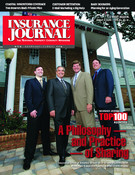New Seismic Models Make Ground Motion Predictions More Accurate
The accuracy of ground motion prediction from shallow events in the active tectonic regions in the Western United States, such as California, has improved, thanks to new ground motion models.
A key component in assessing seismic hazard, and therefore seismic risk, is the prediction of the level of ground shaking that a future earthquake with given characteristics will generate at a specific site. The ground shaking expected at a site depends on its distance from the rupture and on the local soil conditions. In regions that are seismically active — such as California — the intensity of the shaking is predicted by applying statistical regression techniques to ground motion recordings of historical events.
However, strong motion recording stations have been available for only about 80 years. Even today, such stations — with the exception of Japan, Taiwan and part of California — are very sparse in most countries. Therefore, most large, damaging earthquakes that have occurred around the world have gone unrecorded or have been recorded by a limited number of stations. Exceptions are recent events such as the 1995 M7.0 Kobe, Japan earthquake and the 1999 M7.6 Chi-Chi, Taiwan earthquake.
All the seismic hazard and risk studies performed in the past decade were essentially based on attenuation equations, or ground motion prediction equations (GMPEs), developed in the mid-1990s. The GMPEs were not based on the clean data that scientists might have desired. The then-available databases, for example, included a limited number of recordings from large, and therefore rare, magnitude earthquakes (i.e., M>7) at nearby stations.
A New Generation
Since the mid-1990s, the number of strong motion stations deployed worldwide has multiplied, and they have recorded some large-magnitude earthquakes that have occurred since.
To exploit the infusion of new data, in 2003, a multidisciplinary research effort coordinated by the Pacific Earthquake Engineering Research Center-Lifelines Program in partnership with the U.S. Geological Survey and the Southern California Earthquake Center was launched with the mission to develop more reliable and statistically sound GMPEs. The effort, called the “Next Generation of Ground Motion Attenuation Models” (NGA) project, ended in 2007.
The NGA project focused on predicting ground motion from shallow crustal earthquakes in the western United States and similar active tectonic regions — in other words, earthquakes such as those generated by the San Andreas Fault in California.
In addition to performing statistical analyses of the newly augmented database of recordings, the NGA project, also included an extensive study aimed at uniformly reprocessing the recordings and cleaning the database of errors and imperfections. The new database has more than four times the number of recordings and from about twice as many events than any database in existence in the mid-1990s. Most importantly, the new database includes many recordings of large magnitude events at stations close to the rupture — exactly those that were lacking in the mid-1990s datasets.
Five groups of scientists were tasked to work independently on the unified database to produce GMPEs for ground motion from crustal events. The result is a set of five GMPEs that are more reliable and scientifically defensible than previously produced attenuation equations.
What Does It All Mean?
The practical result of the adoption of the NGA GMPEs in the new USGS seismic hazard maps is that at sites along major faults in California — whose hazard is dominated by large magnitude events — the moderate and long period ground motion associated with small probabilities of exceedance (e.g., 10 percent in 50 years) has decreased, sometimes considerably. Given that building codes are based on such values, the reduction implies that the structures in those areas of California that were designed according to previous codes are a bit safer against collapse than previously thought. In less hazard-prone areas of California that are farther away from the main faults — such as the Central Valley — the reduction is not as large.
The new NGA GMPEs represent a quantum leap in the accuracy of ground motion prediction from shallow events in the active tectonic regions in the West, such as California. The larger and cleaner database shows that for large-magnitude events, the ground motion tends to be lower than previously expected.
However, the NGA equations represent just one of several components that have been updated in the newly released USGS Seismic Hazard Maps. To view the “2008 United States National Seismic Hazard Maps,” visit www.usgs.gov.
Topics California Catastrophe USA Earthquake
Was this article valuable?
Here are more articles you may enjoy.


 Coverage Needed: Hundreds of Thousands in SE Now in Flood Zones With New Maps
Coverage Needed: Hundreds of Thousands in SE Now in Flood Zones With New Maps  Ryan Specialty Announces Succession Plan: Pat Ryan to Exec Chair, Turner to Be CEO
Ryan Specialty Announces Succession Plan: Pat Ryan to Exec Chair, Turner to Be CEO  Microsoft Tells Texas Agencies They Were Exposed in Russian Hack
Microsoft Tells Texas Agencies They Were Exposed in Russian Hack  As Rates Rise, Majority of Homeowners Say Insurance Industry Is in Crisis: Survey
As Rates Rise, Majority of Homeowners Say Insurance Industry Is in Crisis: Survey 


